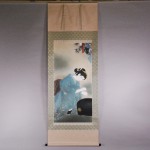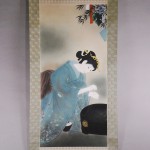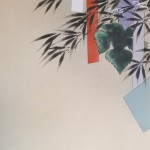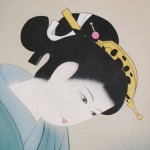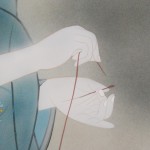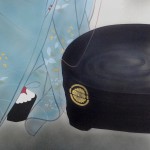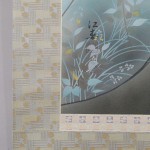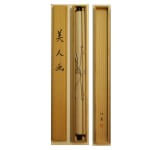Kakejiku Hanging Scroll: Beautiful Woman Painting / Yamamoto Kōshun - Bijinga
- Product ID
- B0021
- Name
- Yamamoto Kōshun
- Profile
A Japanese-style painter
- Size
- 722mm x 1940mm
- Roller End Material
- Red sandalwood
- Material of the Work
- Silk
- Stock Condition
- Sold out
- Description
“Tanabata” is one of the days of “sekku” (a day of the turn of the season) in Japan, China, Taiwan, Vietnam, and Korea. It is one of the “Gosekku” (the five seasonal festivals). Though it refers to the night of July 7 (lunar calendar), “Tanabata Matsuri (festival)” is held in Japan either on July 7 or a month later on August 7, as “Bon” festival is also held either in July or in August, after the Meiji revision of the calendar. Tanabata was originally an event celebrated in China and was introduced into Japan during the Nara period. The term tanabata was born when the above was combined with the Japanese indigenous legend of “Tanabatatsume.”
The legend of the Weaver and the Cowherd first appeared in “The Nineteen Old Poems,” compiled during the Han period and selected in “Bunsen” (literature), but its relationship to July 7 is not clear. In “Keiso Saijiki” written during the period of the Northern and Southern Courts (China), it was stated that the Cowherd and the Weaver meet on July 7, and on that night, women prayed for the progress of sewing by threading colorful threads into the eyes of seven needles and setting up offerings in the garden. From the above description, the fact that “Kikkōden,” which was held on July 7, was linked with the legend of the Weaver and the Cowherd is clearly understood. The following description appears in the “Novel (In Un)” written by Inun in the Rikucho Ryo period (Southern court), “A lady weaver resided in the east of the Milky Way and she was a child of Tentei (God of Hosts). She was always busy weaving “hagoromo” (feather-robes) of “unkin” (clouds and brocade) and had no time to make herself up. Tentei felt pity for her solitude and allowed her to marry Qianniulang (the Cowherd) of the west of the river. When she ceased to weave after being married, Tentei became angry, ordered her to return to the east of the Milky Way, and allowed her to meet him only once a year.” The above is the oldest historical literature that can verify the currently known story of tanabata.
It is thought that tanabata originated as the Japanese traditional festival in which people pray for a good harvest to the spirits of ancestors (Bon festival) merged with Kikkouden, a festival imported from China in which women pray for the progress of sewing, and the Buddhist festival of “Urabon-e” (Bon festival). By writing wishes on “tanzaku” (strips of colored paper) and hanging them on bamboo branches is a common practice around the nation. Hanging tanzaku on bamboo branches is a unique Japanese practice and it was created during the Edo period based on bamboo set at the both sides of cogon grass ring for “Natsugoshi no Oharae” (great purification ceremony). Tanzaku’s five colors, which are mentioned in the lyrics of a song “Tanabata-sama,” refer to green, red, yellow, white, and black based on “Gogyou-setsu” (the theory of five elements). As Kikkouden, mentioned above, is a festival to pray for improving the technique of the arts, it is believed that wishes to be written on tanzaku are supposed to be about accomplishments. Tanzaku is also influenced by five colored-segakibata of Buddhism which is used at the Buddhist service for “segaki” (Hungry Ghosts).
This work is “bijinga” (portrait of a beautiful woman) by Koushun Yamamoto. There is a traditional custom of tanabata in Japan to pray for the progress of sewing by reflecting a starry sky in surface of water in the tub and threading a needle above it. Koushun Yamamoto depicted this custom in his painting. This is a very interesting work through which we can see the Japanese traditional custom.


